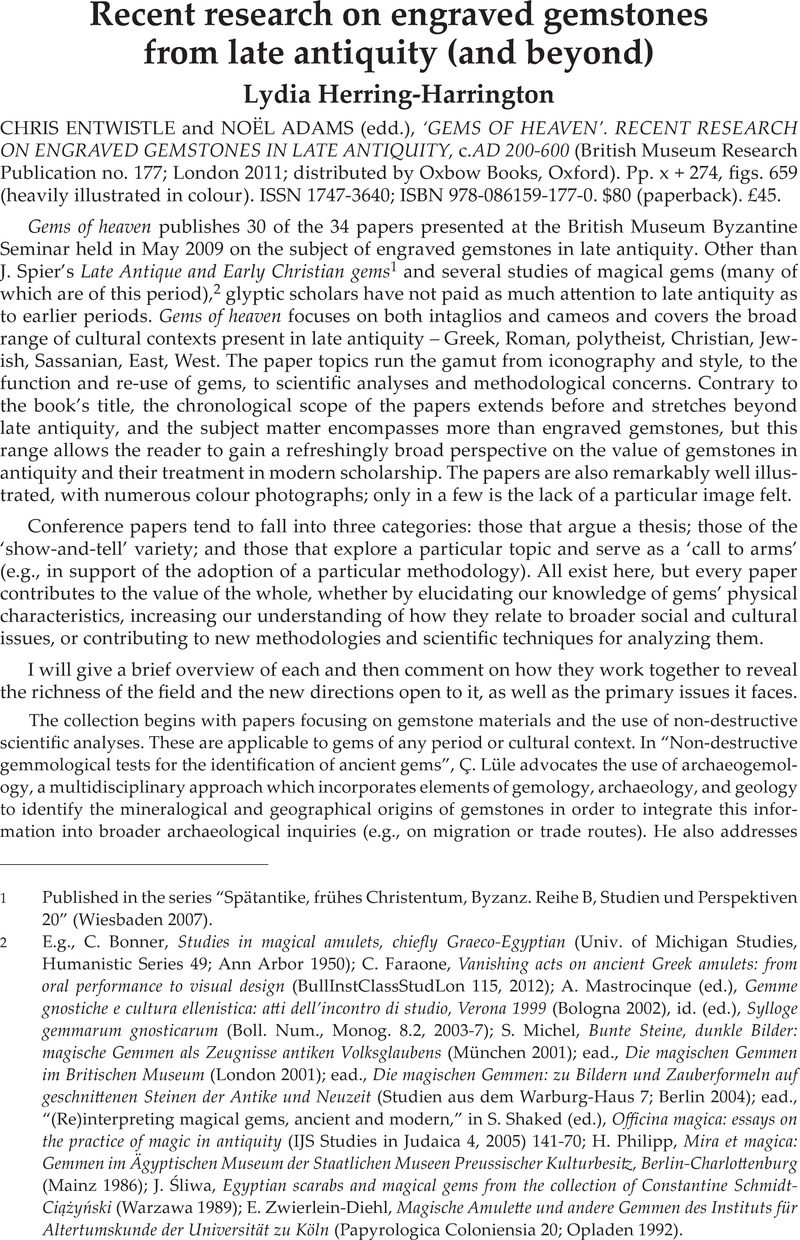No CrossRef data available.
Article contents
Recent research on engraved gemstones from late antiquity (and beyond) - CHRIS ENTWISTLE and NOËL ADAMS (edd.), ‘GEMS OF HEAVEN’. RECENT RESEARCH ON ENGRAVED GEMSTONES IN LATE ANTIQUITY, c.AD 200-600 (British Museum Research Publication no. 177; London 2011; distributed by Oxbow Books, Oxford). Pp. x + 274, figs. 659 (heavily illustrated in colour). ISSN 3640-; ISBN 978-086159-177-0. $80 (paperback). £45.
Published online by Cambridge University Press: 27 November 2014
Abstract

- Type
- Reviews
- Information
- Copyright
- Copyright © Journal of Roman Archaeology L.L.C. 2014
References
1 Published in the series “Spätantike, frühes Christentum, Byzanz. Reihe B, Studien und Perspektiven 20” (Wiesbaden 2007)Google Scholar.
2 E.g., Bonner, C., Studies in magical amulets, chiefly Graeco-Egyptian (Univ. of Michigan Studies, Humanistic Series 49; Ann Arbor 1950)Google Scholar; Faraone, C., Vanishing acts on ancient Greek amulets: from oral performance to visual design (BullInstClassStudLon 115, 2012)Google Scholar; Mastrocinque, A. (ed.), Gemme gnostiche e cultura ellenistica: atti dell’incontro di studio, Verona 1999 (Bologna 2002)Google Scholar, id. (ed.), Sylloge gemmarum gnosticarum (Boll. Num., Monog. 8.2, 2003-7); Michel, S., Bunte Steine, dunkle Bilder: magische Gemmen als Zeugnisse antiken Volksglaubens (München 2001)Google Scholar; ead., Die magischen Gemmen im Britischen Museum (London 2001)Google Scholar; ead., Die magischen Gemmen: zu Bildern und Zauberformeln auf geschnittenen Steinen der Antike und Neuzeit (Studien aus dem Warburg-Haus 7; Berlin 2004)Google Scholar; ead., “(Re)interpreting magical gems, ancient and modern,” in Shaked, S. (ed.), Officina magica: essays on the practice of magic in antiquity (IJS Studies in Judaica 4, 2005) 141-70CrossRefGoogle Scholar; Philipp, H., Mira et magica: Gemmen im Ägyptischen Museum der Staatlichen Museen Preussischer Kulturbesitz, Berlin-Charlottenburg (Mainz 1986)Google Scholar; Śliwa, J., Egyptian scarabs and magical gems from the collection of Constantine Schmidt-Ciążyński (Warzawa 1989)Google Scholar; Zwierlein-Diehl, E., Magische Amulette und andere Gemmen des Instituts für Altertumskunde der Universität zu Köln (Papyrologica Coloniensia 20; Opladen 1992)Google Scholar.
3 The reference in the third line to the catalogue number of the gem depicting Herakles is wrong: it should be I.5 instead of I.4.
4 Mastrocinque, A., “Orpheos Bakchikos,” ZPE 97 (1993) 16–24 Google Scholar.
5 On 223, in the subheading in the left-hand column, “West” should read “East”.
6 Gagetti, E., Preziose sculture di età ellenistica e romana (Il Filarete 240; Milan 2006)Google Scholar; ead., “Statue “di” gemme. Copie miniaturistiche in materiale glittico di tipi statuari celebri,” in Chiesa, G. Sena and Gagetti, E. (edd.), Aquileia e la glittica di età ellenistica e romana: atti del convegno, Aquileia 2008 (Trieste 2009) 219–35Google Scholar. Bartman, E. (Ancient sculptural copies in miniature [Columbia Studies in the Classical Tradition 10, 1992]CrossRefGoogle Scholar and Dahmen, K. (Untersuchungen zu Form und Funktion kleinformatiger Porträts der römischen Kaiserzeit [Münster 2001])Google Scholar also include gemstones in the round in their broader studies of ancient miniature sculpture.
7 Spier, J., “Early Christian gems and their rediscovery,” in Brown, C. M. (ed.), Engraved gems: survivals and revivals (Studies in the History of Art 54; Washington, D.C. 1997) 33 Google Scholar.
8 Spier, J., Ancient gems and finger rings: catalogue of the collection (Malibu, CA 1992) 76 Google Scholar.
9 Two recent examples: Mastrocinque 2012 (providing a historiography) and Sfameni (2010) both use magical gems as evidence for the practice of magic in late antiquity.
10 Sax, M., “Recognition and nomenclature of quartz materials with specific reference to engraved gemstones,” Jewellery Studies 7 (1996) 63–72 Google Scholar.
11 Magical gems have also been called “gnostic”, but this term is no longer current: Gordon 40. See Faraone 50 n.3 for a brief historiography of terminology related to magical gems. Mastrocinque (2012 [supra n.2] 6) now provides a broader overview of their categorization.
12 Cf. Gordon 44-45; Faraone 50; Nagy 75-77.
13 This dilemma relates to the concept of “magic” in the ancient world writ large. Was anything actually “magic” to ancient peoples, or is that a term with value only to modern scholars? The uncertainty is problematic for students of gems.
14 Maaskant-Kleibrink, M., Catalogue of the engraved gems in the Royal Coin Cabinet, The Hague: the Greek, Etruscan, and Roman collections (The Hague 1978) 11–13 Google Scholar.
15 Marsden does not mention any other evidence (e.g., for a setting) that would support the identification as a ringstone.
16 Mastrocinque (supra n.4) 18.
17 Gordon emphasizes the difficulty by proposing a number of ways to work around the lack of provenance; he suggests (39-40) new perspectives on what engraved gems can contribute to scholarship.
18 If there is some reason why they do not — perhaps the data are not available? — they do not make this clear. They do mention (111) a deceased’s remains once.
19 For example, Marsden references Sena Chiesa’s difference of opinion on the identification of a gem, but not Zwierlein-Diehl's alternate proposal (172; also n.48) for a different gem. Harley-McGowan discusses two gems also mentioned in Engemann’s paper, but she references him (217) only for the latter.
20 There are a number of such discrepancies between Marsden and Zwierlein-Diehl. The treatment of a gem depicting Philip I, Philip II and Otacilia Severa that he rejects (169-70) but she accepts (152) is notable because she comments that its authenticity has never been questioned. A gem portraying Carinus and Magnia Urbica that he identifies as inauthentic (171) she identifies (156) as Aurelian and Ulpia Severina; she does mention and refute other identifications for the couple, but accepts the gem’s authenticity without question. As another instance, Sena Chiesa (230) does not mention that Marsden (172) both doubts the authenticity of a cameo she describes as bearing the image of Domitian-as-Minerva and identifies it as Gallienus, though he does acknowledge her work on the gem.
21 While terms such as pleochroism (Adams, Lüle and Passmore 29) are used without definition, overall the text is comprehensible to the non-specialist.




